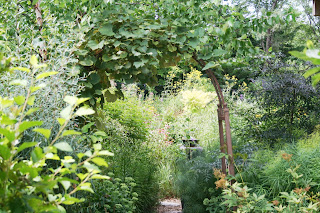Gardening with native plants is a moral imperative. Period. A lot of landscape designers and architects who've been in the business much longer than me often decry my plea for all or mostly native plant landscapes. I tend to have a knee jerk reaction that makes me wonder how stuck in the mud they are.
- "It can't be done where I live"
- "There just aren't enough choices"
- "My clients would never go for it"
So, how many of you landscape designers would lose work if you suggested / pushed more native plants? How much work would you lose? Some say compatible and well-behaved exotics are fine and necessary to use along with natives in order to increase the pallet and diversity -- but do we know when an exotic will become invasive? Do we have proof that it is as beneficial to wildlife, especially pollinating insects (for nectar AND as a host plant)? We'd have to have a plant by plant case study, probably county by county too, but there is much research pointing to the fact larvae need native plants as hosts, and that adult insects have as much of an evolutionary tie to the leaves as they do with the nectar and the flower shapes that draw them in. And that's just what's happening above the soil surface.
So without knowing a plant fully (or predicting the future), how can we responsibly suggest these to clients? How can we garden with ALL of the wildlife in mind or the nearby ecology, a holistic gardening that goes beyond just our artistic ideal and vision, and begin to combine how we see a landscape with what it really is and was before colonization and houses and roads and telephone poles, and how it responsibly rebuilds what we've pushed to the brink and insures a healthy future? Designing with natives is a test of our ethics; we are often bankrupt in that regard. We are lucky to live in a country where environmental destruction is relatively recent -- there are still patches, echoes of native wildness we can take a cue from; they call out to us like someone being carried away in a flash flood. Thousands of species go extinct globally each year, most as a direct result of our action, or inaction.
Gardening can no longer be about aesthetics alone, and this move must start with designers and architects. There is a massive and burgeoning desire to garden locally (it ties into the local food movement) -- plants raised within a nearby radius, plants grown from open-pollinated seed collected within that same radius, plants not sprayed with pesticides. When we begin to garden like this, we know our place more, we connect, we thrive, we care about our home. We live better. Maybe our kids will, too. Suddenly, community means something more. All of the above must be at the center of landscape design in the 21st century, and if it isn't, we aren't designing right.
Sure, gardening with natives may not be as easy, as pie-in-the-sky wonderful, as silver bullet as some make it out to be. And this is where the coaching / teaching on the part of the designer comes in. A gardener must always take an active part in any landscape, native or not, and when they do only then does gardening become easier:
- The right plant in the right spot
- Learning to identify good bugs vs bad
- Allowing for insects and plants to decide their own fates in beds and boarders
- Letting drought tolerant plants go dormant
- Not freaking out when something does not suit our cosmetic ideal, but learning with nature
Maybe we're afraid to face ourselves in our landscapes because we know the implications of our hand in nature, we know what's going on, and to garden in a different way means accepting that how we usually garden may be problematic (to say the least). But how else do you grow? Is gardening with natives really any different than being kind to each other, taking care of ourselves, paying it forward, or ensuring future human freedoms by protecting the planet that sustains us? Of course not.
Gardening with natives is something any landscape designer needs to get on board with and get clients into -- gently or vigorously. Now. We can't just talk about simple maintenance issues or aesthetics, we must go beyond and talk about the health of our planet and our families, clean water, carbon sequestration, helping specific local wildlife, backup ecological systems (redundancy), about nature deficit disorder causing increased mental health issues in children. I do not see how any of these subjects is separate in a designed landscape. Every time we consult with clients the discussion should be as much about the design as the moral implications of that design. This is a new, brave paradigm we desperately need, and it will expand our creativity as landscape managers and engage our clients in more meaningful ways.
We can help each other live and garden better, or we can keep making excuses and shooting holes in the idea of gardening with natives, but the core issues still remain -- our planet is sick, so are we, we have caused it, and we can do something about it. It's simply irresponsible and short-sighted in this day and age, given what we know, to design with an extensive use of non native plants (or lawns and impermeable hardscapes). If designing with native plants is restrictive then our landscape professionals have had a failure of education or imagination, and maybe even hope in the medium they use.








